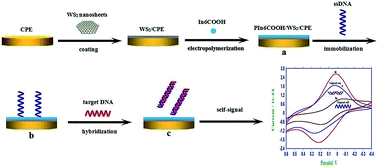Construction of self-signal DNA electrochemical biosensor employing WS2 nanosheets combined with PIn6COOH†
Abstract
In this work, a novel self-signal DNA electrochemical biosensor was constructed based on tungsten disulfide (WS2) nanosheets combined with poly(indole-6-carboxylic acid) (PIn6COOH) as the sensing interface. The WS2 nanosheets were synthesized via a simple solvent exfoliation method from bulk WS2, and then PIn6COOH was electropolymerized on the WS2 nanosheet-modified carbon paste electrode to obtain a unique nanocomposite. The electropolymerization efficiency was remarkably improved, ascribed to the physical adsorption between WS2 nanosheets and aromatic In6COOH monomers, resulting in an increase of the electrochemical response of PIn6COOH. Owing to the presence of π–π interactions between the conjugated PIn6COOH/WS2 nanocomposite and DNA bases, the probe ssDNA was noncovalently assembled on the nanocomposite substrate. After the hybridization of the probe ssDNA with the target DNA, the formation of the double-helix structure induced the resulting dsDNA to be released from the surface of the conjugated nanocomposite, accompanied with the self-signal regeneration of the nanocomposite (“signal-on”). The constructed PIn6COOH/WS2 nanocomposite was not only employed as an interface for DNA immobilization but also reflected the signal transduction stemming from DNA immobilization and hybridization without any external indicators or complex labeling processes. A detection limit of 2.3 × 10−18 mol L−1 has been estimated and a dynamic range of 1.0 × 10−17 mol L−1 to 1.0 × 10−11 mol L−1 has been shown for the detection of a PIK3CA gene related to lung cancer. Selectivity of the biosensor has been researched in the presence of noncomplementary and base mismatched DNA sequences.



 Please wait while we load your content...
Please wait while we load your content...